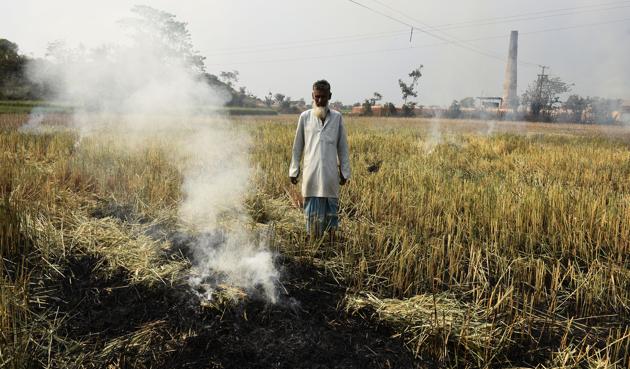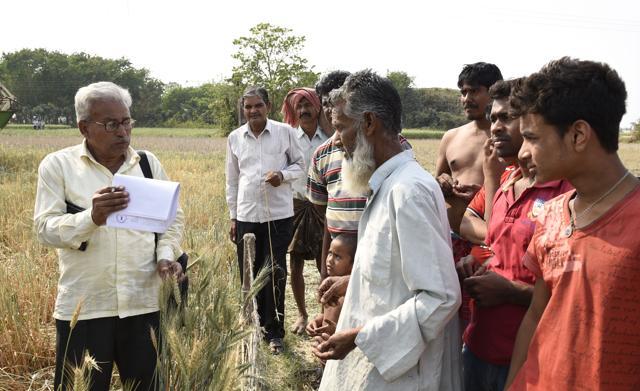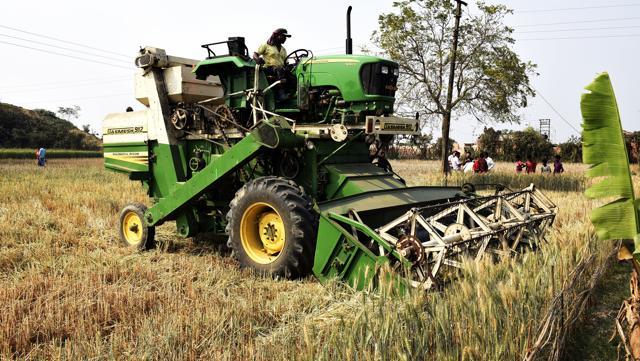Ground Zero: Farmers stare helplessly as govt race against time to contain spread of ‘wheat blast’ like symptoms
The state government has deployed men and machines in the villages including combined harvester machines to chop off the crop, jars of kerosene and spray machines.
Sixty-year-old Dulal Sheikh of Sonpukur village in Chapra Block in Nadia, barely 8 kms away from the Bangladesh border, stands beside his field full of yellow wheat ripe for harvest clasping his forehead. On the backdrop is a blaze, smoke and cracking sound of his crop burning with government officials spraying kerosene to stoke the flames. At the other end of the adjacent plot, a harvester machine is busy felling the crop. Just about 24 hours ago, Sheikh was unaware that his crop with be razed to the ground and burned.

Safat Ali Sheikh, 52, of Hatkhola village under Chapra Block is facing the same ordeal for his 40 decimal land which the giant harvester cleared in a few minutes. Fending for a family of nine, he and his sons are now at a loss as to how they will manage to run it.
The enemy, however, is invisible. The spores can’t be seen with the naked eye. If the fungus attacks a wheat spikelet at one point, it travels upwards and the seeds simply wither away. “We have been told by agricultural officers, the fungus seems to spread by air, and quickly spreads to the nearby plants,” said Sheikh.
For the Mamata Banerjee government, it is a race against time. While the farmers stand helplessly ruing the disease that struck them with lightening speed from across the border, for the agriculture department officers it is a race to clear the fields and burn the wheat to ensure there are no fungal spores that can travel from Bengal to the wheat bowl of the country in the Hindi heartland.
“I have heard they are cutting off my crop and setting fire. I don’t know what happened. They (government officials) said that I will get compensation. But I don’t know when the money will come,” said Safat Ali.
“I have invested Rs 4000 for 12.5 cottah of land in terms of seed and fertilizers. This is apart from the toil me and my son put in. If everything went well I would have got Rs 6,000 for my produce, which means a profit of Rs 2,000. But now I don’t know what will I do,” Dulal Sheikh told HT, while the field burnt.

In Nadia five blocked bordering Bangladesh has been severely hit including Chapra, Tehatta I and II, Karimpur I and II.
Last year, the fungus entered Asia for the first time, creating havoc in Bangladesh where crops of over 20,000 hectares in six districts had to be burnt. In Bengal it has already spread to Murshidabad and Nadia districts bordering Bangladesh forcing the government to sound a red alert.
The HT team visited a number of villages in Chapra I block in Nadia district. The scene was the same at Sonpukur, Hatikhola, Mohotpur, Sikra and other villages near the Indo-Bangladesh border.
“On Sunday, I visited a field in one of the villages and saw a couple of spikelets and detected symptoms of wheat blast. After two days I visited again and to my dismay found that 30% to 40% of the entire crop in the plot affected. We are not taking any chance whatsoever. We are calling it wheat blast like disease, since confirmation is yet to come,” said Pranab Kumar Hembram, assistant director of agriculture (Chapra block), who was seen with a team of panchayat and government officials running around in the villages since 7 am on Saturday.
Read: Fungus sees wheat crops in Bengal go up in flames as govt controls its spread
The state government has deployed men and machines in the villages including combined harvester machines to chop off the crop, jars of kerosene and spray machines.
“On Sunday a notification was issued by the state government. We are felling the crop first and then spraying kerosene and setting the field on fire. We must ensure that all crops and seeds are destroyed. The spores which spread through air has to be contained,” said Arun Roy, project co-ordinator and additional direct state agriculture department, who have been sent by the state secretariat to oversee the containment initiative.
Though no government officer would say it on record, they indicated that the farmers would do well to avoid sowing wheat for the next two-three years.

Initially, panchayat and government officials faced resistance but were able to convince farmers of dangers of the deadly disease.
“Initially there was some resistance among farmers. But we were determined since this is serious issue. We convinced them ultimately,” said Mrinal Kanti Tarafdar, sabhapati of Chapra panchayat samity.
But there are gaps in the crop destruction process. Wherever men and machinery are not available, the government is not able to deploy harvesters. The officers are directing the farmers to destroy the crop themselves. The irony is, most of the farmers are so poor that they are not able to afford the required to fell and burn the crops -- an exercise that will deliver an additional financial burden.
The administration is offering Rs 50,375 as compensation for crop destroyed of per hectare. “The amount is paltry and we are not sure when the money will be disbursed,” said Atiur Khan, a farmer of Sonpukur. He has 17 bigha of land and he has cultivated in 1.5 bigha.
Nadia is one of the most fertile tracts of Bengal with Gangetic alluvial soil flowing from both the Ganges and Padma enriching the fertility of the tract. Agriculture officers pointed out that the district displays a remarkable variety of crop diversity with jute to paddy, wheat to onion, oilseeds to vegetable.
Fortunately, the fungus affects only wheat and, as a result, the fields next to the wheat that are laden with red chilli and onion are safe.





